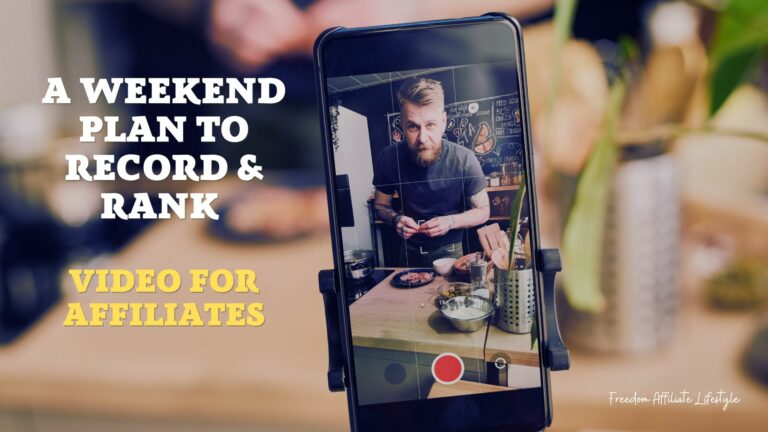Starting a blog can be exciting but also somewhat overwhelming, especially if you’re new to the process. With so many tips and strategies out there, it’s hard to know where to begin!
In this guide, we’ll walk you through each essential step to writing a blog post, from understanding your audience to refining your content after publishing. So if you’re hoping to share your passions, build an online business, or connect with a new audience, these beginner-friendly strategies will help you create engaging, well-structured blog posts that keep readers coming back for more.
Table of Contents
Affiliate Disclaimer: This site contains affiliate links, which means I may earn a commission on purchases made through these links at no extra cost to you.
1. Understanding the Purpose and Audience of Your Blog

The foundation of a successful blog post begins with a clear purpose and an understanding of your audience. This first step is all about focusing on the “why” behind your blog and tailoring your content to connect with the right readers.
Identify Your Niche
Every blog needs a well-defined niche (a specific topic or area) that appeals to a focused audience. Rather than trying to cover everything, pick a niche that you are passionate about and one that offers plenty of opportunities for content. It could be travel, tech, personal finance, health and fitness or any other area. Narrowing it down helps attract an audience with similar interests. For affiliate marketers, focusing on a profitable niche also means you can provide content that’s relevant to products or services you might want to promote later on.
Ask yourself:
- What are my passions or areas of expertise?
- Are there specific problems or needs within this area that I can address?
Once you identify a niche that combines your interests and potential audience needs, you’re setting yourself up for content that’s authentic, valuable, and engaging.
Know Your Target Audience
Start by picturing your ideal reader: What challenges are they facing? What are they hoping to learn or solve?
Do a bit of audience research by looking at forums, social media groups, or even blog comments within your niche to see what topics and questions come up frequently.
To get to know your audience, consider:
- Age, profession, or interests of your readers
- What kind of solutions or insights they’re searching for online
- How familiar they are with your topic or industry
Define Your Goals
Every blog post should serve a purpose. Are you trying to educate, entertain, or drive traffic to your website? Are you aiming to introduce a product, provide value, or inspire a call to action? Defining your goals helps to shape the tone and style of your posts.
Common goals for blog posts include:
- Educating readers on a specific topic
- Entertaining and engaging your audience
- Driving traffic to build brand awareness
- Promoting a product or service
By aligning each post with a goal, you keep your content intentional and impactful, making it easier to create posts that connect and convert.
2. Planning Your Blog Post

When you are planning a blog post, you need to take the time to create a structure for it. This will keep things organized and effective.
Choose a Relevant Topic
- Google Trends: Use this to see what’s currently trending in your niche, which can help you catch the attention of readers looking for timely content.
- Answer the Public: This tool shows common questions people search for related to a specific keyword, helping you create content that addresses real audience queries.
- Keyword Research Tools: Platforms like Ahrefs, SEMrush, or JAAXY allow you to find high-volume, low-competition keywords, which can help boost your blog’s visibility in search engines.
Outline the Structure
A basic outline might look like this:
- Introduction: Briefly introduce the topic and why it matters. Hook the reader’s attention and explain what they’ll learn or gain by reading on.
- Body: Divide the body into several main sections, each covering a specific point or step. Use subheadings to separate sections, making it easier for readers to scan.
- Conclusion: Summarize the key points and encourage readers to take action, whether that’s reading more, sharing the post, or exploring a related product or service.
Set a Goal for Each Section
Setting a purpose for each section of your blog post helps make sure that your content is well-balanced and purposeful. As you outline, think about what you want each section to achieve… whether it’s engaging, informing, or driving a call-to-action (CTA).
Assigning a goal to each section lets your post flow naturally and also keeps your readers engaged from start to finish.
3. Writing the First Draft

After you have a clear plan in place, it’s time to start writing your first draft. This is where you bring your ideas to life. Here are some tips to guide you through this stage:
Craft an Engaging Introduction
Your introduction is your first impression, so it needs to hook readers right from the start. A good introduction should capture attention and show readers that your post will meet their needs or solve a problem they’re facing.
Start by addressing a common pain point, asking a thought-provoking question, or sharing an interesting fact that relates to your topic. Then, give readers a preview of what they’ll gain by continuing to read.
For example:
- If you’re writing about SEO basics, you might open with: “Want to get more eyes on your blog? SEO can help make your content easier to find, but it can also feel overwhelming for beginners. This guide breaks down the essentials so you can get started quickly and confidently.”
A strong, engaging introduction encourages readers to stick around for the rest of your post.
Develop Clear and Concise Main Points
In the body of your post, aim to cover one main idea per paragraph. This keeps your writing clear and helps readers follow along. For each point, add value by including examples, statistics, or actionable tips. Breaking down complex ideas into bite-sized pieces also makes your content easier for beginners to understand.
- Whenever possible, use examples to illustrate your points, as they help readers see how to apply the information in real life.
- Providing tips and actionable steps makes your content practical and encourages readers to take action based on your advice.
Incorporate Visuals and Break Up Text
Tips for adding visual appeal:
- Use Images and Graphics: Relevant images, screenshots, or infographics add context and visual interest, helping explain complex ideas.
- Add Bullet Points and Lists: Bullet points and numbered lists make key points stand out and allow readers to skim easily.
- Keep Paragraphs Short: Aim for paragraphs of 2-4 sentences, as this format is less overwhelming and easier to follow on screens.
Related Article at FreedomAffiliateLifestyle.com!
Check out this article about “High Ticket Affiliate Marketing” and learn about the income potential higher ticket products can bring.
4. Optimizing for SEO

Search engine optimization (SEO) is essential for driving organic traffic to your blog. By strategically using keywords, optimizing meta information, and linking thoughtfully, you increase the chances of ranking higher on search engines, making your content more discoverable. Here’s how to approach SEO in a beginner-friendly way.
Use Keywords Strategically
Keywords are the terms and phrases that your audience is searching for. Integrating these keywords naturally throughout your post helps search engines understand what your content is about. However, be sure to avoid keyword stuffing, as search engines may penalize content that seems forced or unnatural.
Add Meta Description and Alt Tags
Meta Description: This is a brief summary of your post that appears on search engine results pages (SERPs). Write a concise (around 150–160 characters) meta description that captures the main point of your post and includes your primary keyword. A good meta description can entice readers to click, boosting your post’s visibility.
Example: “Learn step-by-step strategies for writing a blog post that attracts readers and ranks well in search engines. Perfect for beginners looking to start strong!”
Alt Tags: Alt tags (or alt text) describe images for both search engines and visually impaired users. They help search engines understand the content of images, which can improve your blog’s SEO. Use descriptive phrases that include relevant keywords when it makes sense, but keep them straightforward.
Internal and External Links
Linking to relevant content within your site (internal links) and credible sources outside of it (external links) can boost SEO and provide added value for readers.
Internal Links:
Example: If you’re writing about keyword research, you could link to another post on “Top Keyword Research Tools for Beginners.”
- External Links:
Example: If you mention SEO guidelines, link to Google’s official Webmaster Guidelines for extra authority.
6. Adding a Call-to-Action (CTA)

An effective Call-to-Action (CTA) encourages readers to take the next step, whether that’s engaging with your content, joining your email list, or exploring more on your site. CTAs are key to converting casual readers into loyal followers or customers, and they provide a clear direction for readers to continue their journey.
Guide Readers to the Next Step
Every blog post should aim to leave readers with a sense of what to do next. A CTA doesn’t have to be complicated; it simply needs to direct readers toward a specific action. Think about what makes the most sense based on the post’s content and your broader goals. Common CTAs for blog posts include inviting readers to:
- Comment or Share
- Sign Up for a Newsletter
- Read Related Posts
- Explore Products or Services
Make It Relevant and Clear
- Use Action-Oriented Language: Phrases like “Discover,” “Explore,” “Join,” or “Learn More” prompt readers to take action in a clear, engaging way.
- Highlight the Benefit: Explain what readers will gain by following the CTA, whether it’s more information, a useful resource, or a chance to join a community.
- Keep It Short and to the Point: A concise, well-placed CTA is more effective than a lengthy or complex one. Aim for one to two sentences that clearly communicate the next step.
For instance, at the end of a post on blogging basics, a CTA might read: “Ready to start your blog? Check out our beginner’s guide to choosing the right blogging platform!”
7. Publishing and Promoting Your Blog Post

Once your blog post is written, optimized, and has a clear CTA, it’s time to publish and promote it. Giving your post a strong start through effective promotion and engagement is key to building visibility and attracting readers.
Optimize for Mobile
With a growing number of people reading blogs on their phones, it’s extremely important to make sure that your post looks great and functions well on mobile devices. Before publishing, preview the post on both desktop and mobile views to check for readability and design. Here are a few mobile-friendly tips:
- Short Paragraphs and Headings: Breaking up your content with short paragraphs and headings makes it easier to read on smaller screens.
- Responsive Images: Ensure that all images adjust to fit the screen size, avoiding any awkward cropping or slow load times.
- Clear CTAs: Make sure any buttons or links within your CTA are large enough to be easily tapped on a mobile device.
Share on Social Media and Email Lists
- Social Media: Share your post on platforms where your target audience is active, like Facebook, Twitter, LinkedIn, or Pinterest.
- Email Newsletter: If you have an email list, send a quick email introducing the post and linking to it. Include a teaser of the content that entices readers to click through.
Engage with Readers
- Ask for Feedback: Invite readers to share their thoughts on the topic or ask if they have additional tips to add.
- Prompt Further Action: Encourage readers to bookmark the post, follow you on social media, or subscribe for more tips.
- Respond Promptly: A quick, thoughtful reply to comments builds trust and may encourage more people to participate in future posts.
For example: “Thanks for reading! Let us know in the comments what part of blogging you find most challenging—your insight helps us create content that’s even more helpful for beginners like you!”
extre
8. Analyzing and Learning from Each Post

By tracking metrics, gathering feedback, and refining your approach over time, you’ll create more effective, impactful content that grows your blog’s reach.
Track Performance Metrics
- Page Views and Traffic Sources: See how many people are reading your post and where they’re coming from (search engines, social media, email, etc.).
- Bounce Rate: This metric shows the percentage of visitors who leave your site after viewing only one page. A high bounce rate might indicate that readers aren’t finding what they expected, or that the content isn’t engaging enough to keep them browsing.
- Average Time on Page: This tells you how long readers are spending on each post. Higher times usually mean readers are more engaged with the content.
- Conversion Metrics: If your post includes a CTA, track metrics like email sign-ups, shares, or clicks on affiliate links to gauge how well the CTA is working.
These insights can guide you on what’s working and what may need tweaking in your future posts.
Refine Your Process Over Time
Blogging success is a gradual process, and refining your approach is part of the journey. Take time every few months to evaluate what you’ve learned from previous posts, and update your content strategy accordingly. Here are some ways to refine your process:
- Adjust Content Topics: As you notice trends in what topics perform well, focus on those areas and plan future posts around related themes.
- Experiment with Formats: If longer guides do well, consider writing more in-depth posts. Alternatively, if readers prefer concise tips or listicles, adjust your content style to match those preferences.
- Update Older Content: Keep your top-performing posts relevant by periodically updating them with new information or fresh visuals. This not only improves SEO but also ensures readers are seeing current, valuable insights.
By regularly analyzing and adapting, you’ll build a blog that consistently delivers quality, draws in readers, and evolves with the interests of your audience. This continuous improvement cycle is key to growing and maintaining a successful blog over time.

THIS IS HOW I MAKE MONEY ONLINE!
- Build your own website based on your passions and interests
- Generate consistent monthly income
- Grow and monetize your social media platforms
- Work from anywhere and create passive income streams

Elizabeth teaches people how to make money online through affiliate marketing. Her tips and strategies help readers earn a Full-Time Income from home. She shares easy steps for success on her blog. Follow her to start your journey!







